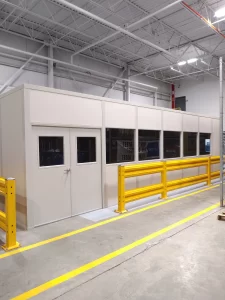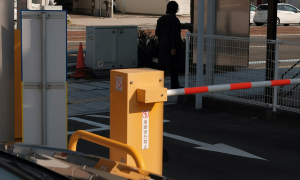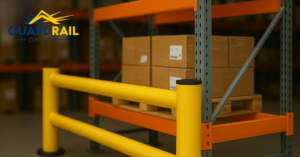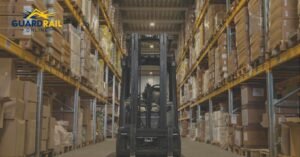Did you know that according to OSHA, warehousing and storage facilities remain among the most dangerous workplaces in the U.S.? These spaces are known to experience frequent incidents involving slips, collisions, and falling objects.
Maintaining safety in warehouse is highly crucial but equally complicated. Most warehouses rely on a combination of employee training, visual cues, and scheduled inspections to maintain a safe work environment. However, these approaches on their own may not be enough.
One of the most effective ways to reduce accidents and bring order to busy work zones is through solid warehouse barriers. Installing warehouse barriers in Louisiana facilities ensures that vehicles, workers, and sensitive equipment all remain in their designated paths. The mere presence of a quality, strong, and robust safety barrier has often proven to minimize the risk of overlap or impact. But what zones within your warehouse must have barriers installed?
This may seem like a very complicated question. However, installing forklift barriers in the right locations would prove instrumental in enhancing safety. Hence, this article aims to talk about 7 key zones where you must strategically place warehouse barriers to prevent accidents, protect property, and keep your warehouse running safely and smoothly.
1. Enhance Safety Around Loading Docks and Dock Edges
Loading docks are one of the busiest areas in a workplace that see constant traffic. Trucks are constantly coming in and out, forklifts are backing up while pallets are continuously moving. Do you think such areas can risk even one misstep? Even an inch of movement into the wrong direction can lead to forklifts tipping over. That would not just lead to loss of products or damage to the forklift. It could also seriously hurt the operator of the forklift or a worker loading products from a nearby truck. However, all this could be prevented by a mere presence of a heavy-duty warehouse barriers in Louisiana. Barriers installed at the dock perimeters would prevent the wheels of the forklift, trucks, or pallet from rolling off. Their presence would also act as the stopwatch for the operator to know exactly when and where to press the brakes or to alert the to stay clear of the drop-off zone.
Installing warehouse barriers in Louisiana around the edges of the docks also help direct drivers into precise parking positions. This simple act can speed up the process of loading and unloading drastically. Moreover, strategically installed safety barriers can also help shield loading ramps, dock locks and hose connections from accidental damage. You can eliminate a major source of downtime and drastically improve the overall safety around the dock for everyone by installing barriers around docks.
But wait! You cannot just install any type of warehouse barriers around loading docks in Louisiana. Choose the most durable, heavy-duty, and double-height warehouse barriers in Louisiana around the edges of the dock. These types of barriers will absorb impact and deflect vehicles back into the safe zone. On the other hand, single-height guardrail barriers can be installed around the corners of the dock’s doors and frames to prevent it against damage from forklifts. It is also wise to pick forklift barriers with high-visibility paint to ensure they are easily visible from long distances.
2. Reinforce Safety in Narrow Aisleways
Walking down a warehouse aisle can often feel like threading a needle, requiring extreme precision and skill. But why wouldn’t it feel like that when forklifts, pallet jacks, and carts might all be moving and squeezing in through the same corridors. Operators of these forklifts or carts are always required to be extra careful. After all, a small bump can topple boxes, dent racks, or injure a nearby team member. Fortunately, you can prevent these mishaps by placing warehouse barriers in Louisiana along every narrow aisle edge.
Installing a low-profile guardrail directly before your racks can act as a much-needed buffer zone. They can intercept wandering wheels before they clip a post or knock over a stack. Not only that, the mere presence of these safety barriers allow operators to instinctively stay in their lane, leaving space between the barrier (and racks) as well as their forklift, carts, or pallet jacks. If that’s not enough, you can choose to install bright-colored barriers, offering enhanced visibility even in low light or Dusty conditions.
Do you have some aisles that are specifically more packed than others? Consider installing double‑height warehouse barrier in such places. The top rail of these safety barriers will stop the stray pallets or forklifts, while the top rail will catch forks before they swing into neighboring lanes. These types of barriers often come in modular sections so you can even lengthen or shift them whenever you plan to reconfigure layouts.
At the end of the day, it is crucial to understand that investing in aisle way barriers does more than protect inventory. It gives your team confidence to navigate tight corridors without hesitation. Less product damage would mean fewer work stoppages. Moreover, you’ll notice smoother operations when drivers and pedestrians stick to their designated paths.
3. Organize Main Traffic Lanes for Smooth Flow
Main traffic lanes feel like busy pathways inside your warehouse. Forklifts, pallet movers, and maintenance carts all share this space. These areas need clear separation. Failing to separate these places are bound to cause cross‑traffic collisions that can bring the entire line to a standstill. But you can prevent confusions, sudden stops, and costly damage by installing quality warehouse barriers in Louisiana.
Installing safety barriers in the center or along the corner of these lanes can create clear in‑and‑out paths. Low guardrails on each side can help define where vehicles should travel. Drivers would instinctively follow these lanes, avoiding dangerous cross‑traffic. Moreover, you can choose to place reflective markers and painted arrows alongside the guardrails to offer drivers more and instant visual guidance. These markers on the forklift barriers would make them impossible to miss—even in low light.
But what if a forklift attracted the lane too fast, unable to stop? High-strength warehouse barriers in Louisiana would help shield walls. They would also prevent collisions by absorbing the impact from forklifts and guide the vehicle back on track, preventing it from tipping or colliding with another vehicle. This simple redirection would save hours of downtime and reduce repair bills.
4. Strengthen Control in Receiving and Staging Areas
Receiving and staging areas are the starting point for every incoming shipment. This is where pallets arrive, boxes are unpacked, and materials are sorted before they move into the main storage zones. But what happens when all of this activity happens at once? With workers handling stock, forklifts unloading goods, and deliveries arriving back-to-back, even the slightest misjudgment can cause accidents. A poorly positioned pallet or a rushed forklift often bound to quickly bring the entire process to a halt. That’s exactly why warehouse barriers in Louisiana are critical to maintain order and safety in these areas.
Installing sturdy barriers along the perimeter of your staging zone creates a defined workspace. It ensures that forklifts stay out of pedestrian-heavy sorting lanes unless they are absolutely required. You can add gate-style barriers at entry points of these zones. These barriers can help supervisors decide when it’s safe for equipment to pass through. This type of physical separation also reduces the chances of sudden run-ins and gives everyone a better sense of space and movement within the zone.
Consider using high-visibility paint or reflective stripes on these safety barriers to further enhance safety. This will ensure workers and vehicle operators notice the boundaries even during night shifts or in dim lighting. You could also place signs to guide movement within the area.
Investing in warehouse barriers in Louisiana will improve loading accuracy, reduce product damage, and minimize delays caused by unnecessary confusion. Operators would become more alert, sorters would be able to work more efficiently, and the entire receiving process would end up becoming easier to manage.
5. Safeguard Mezzanine Edges and Elevated Platforms
Mezzanines and elevated platforms are a practical way to expand usable floor space within a warehouse. They offer the extra room you need for storage, workstations, or even light machinery without having to extend the building. But while they add functionality, they also bring a serious risk, the risk of falling from height. Whether it’s a team member walking near the edge or a pallet jack being used on an upper platform, the absence of physical barriers can turn one misstep into a major accident. That’s why securing these raised areas with warehouse barriers in Louisiana are not just smart but essential.
Installing dual-height guardrails around mezzanine edges can create a clear, physical boundary that protects people and equipment. A lower rail at waist level would stop carts and pallet jacks, while the upper rail would help prevent workers from walking too close to the drop.
The mere presence of barriers on mezzanine would alert your team alert, especially in areas where distractions are common. These safety barriers would also serve as a protective enclosure for any inventory or equipment placed on the upper levels. Additionally, they would help you meet OSHA standards and warehouse safety regulations when combined with clearly visible paint and safety signage.
6. Protect Machinery and Equipment Perimeters
Heavy-duty equipment is the backbone of any warehouse. Unfortunately, forklifts or pallet jacks could be a threat to these expensive, essential machines. Forklifts and pallet jacks have a crucial role to play in your space, but even a slight miscalculation in their movement can lead to serious damages and major disruptions. All it may need is a slight nudge on the corner to damage the conveyor belts and halt production. Such risks are real and often the main cause of delays in warehouses. Luckily, you can prevent such incidents from happening by investing a small sum of money in buying warehouse barriers in Louisiana.
Surrounding machinery with low-profile guardrails can help define clear no-go zones for vehicles. One of the best benefits of these barriers is that they can be shaped and installed the way you like. They are designed to offer protection to any type of machinery, whether they have a straight or L-shaped layout. You can also choose to install double-height barriers if your machines have elevated platforms or exposed drive parts. These offer additional protection from forklift forks or cart edges that may rise too high.
But what if you have areas where technicians regularly carry out maintenance or cleaning? Many reputed sellers provide safety barriers featuring removable sections. These can be temporarily detached and easily reattached once the task is complete. This one change can help reduce downtime, extend machinery lifespan, and keep production running smoothly across every shift.
7. Define Battery Charging and Maintenance Zones
Battery charging stations inside a warehouse are more than just utility corners. These spaces are actually high-risk zones. Acid spills, hydrogen gas emissions, and loose charging cables can all create an unsafe environment, especially when combined with heavy foot traffic or passing forklifts. Clearly marking these areas with sturdy warehouse barriers in Louisiana can however help separate activity zones and reduce chances of costly mishaps.
Installing solid guardrails or steel bollards around your charging points would prove beneficial in more ways than one. They would act as a physical shield to protect chargers and battery racks from accidental vehicle hits. These safety barriers would also guide forklifts into proper alignment, making it easier for drivers to park and connect safely. In addition, these barriers would prevent other vehicles or workers from entering during active charging sessions, especially in areas where the risk of sparks or leaks is highest.
You are doing more than creating boundaries by installing safety barriers around battery charging stations. You are actually creating a safer space for technicians to work. Moreover, you are minimizing chances of costly damage to charging equipment, risk of fire, acid exposure, or injury.
Conclusion
Every square foot of your facility carries its own risks, whether it involves fast-moving forklifts, stacked inventory, or high-traffic staging zones. Hence, warehouse safety should never be left to chance. You need to be proactive and strengthen the safety of your warehouse any chance you get. Installing warehouse barriers in Louisiana is one crucial measure to enhance safety within the high-working environment of a warehouse. It helps to create a well-defined and structured physical separation where people, equipment, and goods can move without conflict or confusion.
When placed strategically, safety barriers will help operators follow fixed routes, protect valuable machinery, and guide workers through busy environments with confidence. This would directly lead to fewer accidents, lower repair costs, and a more organized flow of operations across every shift. But you cannot just rely on any warehouse barriers in Louisiana. You need strong, durable, and highly visible guardrails.
At Guardrail Online, we strive to provide just the warehouse barriers that make safety simple and effective. Our wide range of warehouse barriers are designed to meet the specific needs of every facility layout. We offer durable solutions built for lasting protection irrespective of whether you are looking to protect mezzanines, equipment perimeters, or dock areas. Connect with Guardrail Online today and take the next step toward a safer, more dependable warehouse environment.





